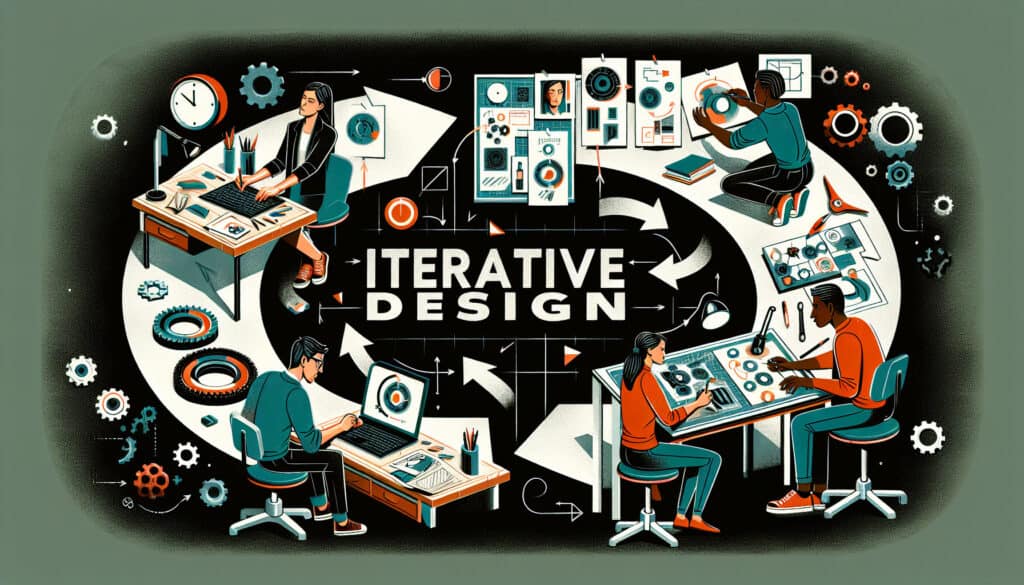A design methodology based on a cyclic process of prototyping, testing, analyzing, and refining a product or process.
- المنهجيات: العملاء والتسويق, الاقتصاد, تصميم المنتج
Iterative Design

Iterative Design
- المنهجية الرشيقة, التحسين المستمر, عملية التصميم, مراجعة التصميم, التفكير التصميمي, التطوير التكراري, النماذج الأولية, تصميم يركز على المستخدم
الهدف:
كيفية استخدامه:
- A design process that involves creating a series of prototypes that are tested and refined in a cyclical manner. This allows designers to get feedback from users early and often, and to make improvements to the design throughout the development process.
الايجابيات
- Allows for flexibility and adaptation throughout the design process; Reduces the risk of failure by getting feedback early and often.
سلبيات
- Can be time-consuming and may not be suitable for projects with tight deadlines; Can lead to scope creep if not managed carefully.
الفئات:
- الهندسة, تصميم المنتج
الأفضل لـ
- Developing new products and services in a flexible and تتمحور حول المستخدم way.
Iterative Design is particularly beneficial in industries such as consumer electronics, automotive, software development, and healthcare, where rapid technological advancements and user preferences are constantly evolving. This methodology is typically employed during the product development phase, where designers and engineers collaborate with end-users to create multiple versions of a product, each refined based on user feedback, usability studies, and testing results. By initiating this process, cross-functional teams including designers, product managers, engineers, and marketing representatives يخطب in brainstorming sessions that encourage creative solutions to user problems. For example, in software development, beta testing phases are a form of Iterative Design where software can undergo multiple rounds of revisions based on user interactions, ultimately leading to a more polished final product. In the consumer electronics sector, companies like تفاحة and Samsung often release prototypes to small user groups to gather detailed feedback on design, functionality, and user experience before launching the final version. This approach not only accelerates innovation but also minimizes the risk of market failure since real user expectations and experiences are considered in each iteration, allowing teams to pivot quickly in response to feedback without substantial resource investment in a single untested design.
الخطوات الرئيسية لهذه المنهجية
- Define user needs and requirements based on stakeholder input.
- Sketch initial design concepts that address user needs.
- Create low-fidelity prototypes to visualize concepts.
- Conduct usability testing with target users on prototypes.
- Gather user feedback and identify areas for improvement.
- Refine design based on feedback and insights.
- Develop higher-fidelity prototypes incorporating revisions.
- Repeat usability testing with updated prototypes.
- Continue iterating until user satisfaction and design goals are met.
نصائح للمحترفين
- Incorporate user الناس into your prototypes to address specific needs and preferences of different user segments.
- Utilize A/B testing on design variations to gather comparative data and make informed decisions based on user behavior.
- Implement rigorous documentation at each iteration to track changes, decisions, and user feedback systematically, facilitating later phases of development.
لقراءة عدة منهجيات ومقارنتها, نوصي باستخدام
> مستودع المنهجيات الشامل <
مع أكثر من 400 منهجية أخرى.
نرحب بتعليقاتكم على هذه المنهجية أو المعلومات الإضافية على قسم التعليقات أدناه ↓، وكذلك أي أفكار أو روابط متعلقة بالهندسة.
السياق التاريخي
1949
1950
1950
1960
1960
1960
1960
1940
1950
1950
1958
1960
1960
1960
1960
(إذا كان التاريخ غير معروف أو غير ذي صلة، على سبيل المثال "ميكانيكا الموائع"، يتم تقديم تقدير تقريبي لظهوره الملحوظ)















منشورات ذات صلة
استبيانات الانزعاج العضلي الهيكلي
الاختبار متعدد المتغيرات (MVT)
تحليل الانحدار المتعدد
أنظمة التقاط الحركة
طريقة MoSCoW
اختبار متوسط المزاج